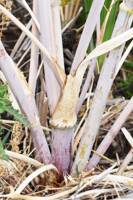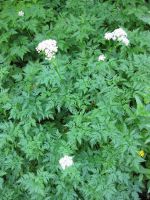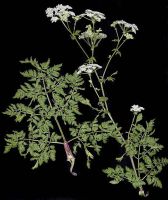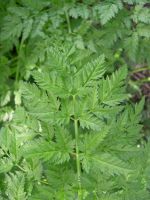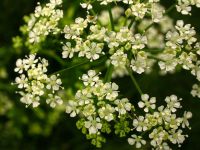Distribution: Occurring on both sides of the Cascades crest in Washington; widely distributed throughout North America.
Habitat: Roadsides, fields, wastelots, and other disturbed open areas, often where soil is moist.
Flowers: April-August
Origin: Introduced from Europe
Growth Duration: Biennial
Conservation Status: Not of concern
Edibility: EXTREMELY TOXIC EVEN IN SMALL AMOUNTS WHEN INGESTED BY HUMANS AND LIVESTOCK.
Pollination: Generalist
Coarse, freely-branched biennials from a stout taproot, 0.5-3 m. tall, with purple-spotted, hollow stem.
Leaves large, all cauline, ternate-pinnately dissected, the ultimate segments small.
Compound umbels numerous, the rays sub-equal, 1-4 cm. long; involucre and involucel of several small, lanceolate bracts or bractlets; calyx teeth obsolete; petals 5, white.
Stylopodium depressed-conic; fruit glabrous, broadly ovoid, 2-2.5 mm. long, with prominent, raised, wavy, almost-winged ribs.
EXTREMELY TOXIC EVEN IN SMALL AMOUNTS WHEN INGESTED BY HUMANS AND LIVESTOCK.
Publication: Sp. Pl. 1: 243. 1753.
PNW Herbaria: Specimen records of Conium maculatum in the Consortium of Pacific Northwest Herbaria database
WA Flora Checklist: Conium maculatum checklist entry
OregonFlora: Conium maculatum information
E-Flora BC: Conium maculatum atlas page
CalPhotos: Conium maculatum photos












